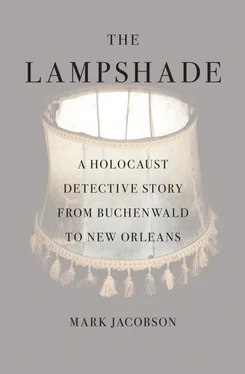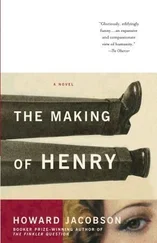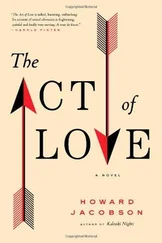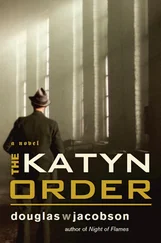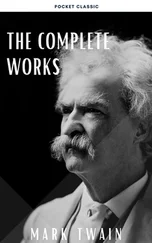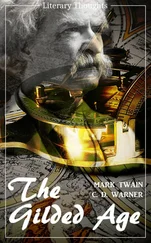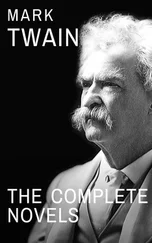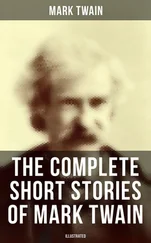“Incredible what people will do,” he said. “What can you say? It is one of those unthinkable sort of things.”
Minyard leaned back in his chair. “I’ve thought about it, what it might have been like to have done this work at a concentration camp, at a place like Auschwitz, when you’re looking at so many bodies. Taken one by one I don’t think determining the cause of death would be that difficult. You’d have asphyxiation, choking, circulatory collapse, pulmonary edema, gunshot wounds, blows to the head. You could put the reports together in a nice, neat pile. But ‘the why’—the why of it—that would be another thing altogether. Forensics are never going to answer that, why people would do something like that to other people.”
Minyard took another look at the photo of the lampshade. “That’s a sad thing you have there,” he said.
Asked if he saw any reason why, out of all places, a lampshade identified with Nazi concentration camps would turn up in New Orleans in the aftermath of Katrina, Minyard said that if you didn’t count the obvious answers, “like it was brought back by some vet,” this was a troubling mystery. Katrina had turned everything upside down, “shaken things loose.” There had been many times since the storm, Minyard said, when he had felt truly lost, that the world he grew up in was “off its compass.”
“There’s a warehouse downtown where we have as many as one hundred bodies of people killed in the storm. We’re just storing them there. Some of the corpses are unidentified, but we know who a lot of them are. But when we notified someone and said, ‘We’ve got your uncle Fred here,’ they said, ‘Why don’t you just keep him?’” The unclaimed bodies kept turning up. “We’ve found thirty-five bodies since we stopped looking for bodies, so what can I assume?”
It bothered Minyard, “this kind of disregard,” the namelessness of it all. “You know, the records from our potter’s field were washed away in the storm. It is almost like dying twice and still nobody knows you. The murders are just more of it. We had two shootings here yesterday. We might have two today. Two more tomorrow. The police can’t stop it. They can put a dent in it, but they can’t stop it. Maybe no one can stop it, not the politicians, not the pastors. I’d like to think God can, but he hasn’t seen fit to do that. Not yet.”
If a human skin lampshade was going to turn up somewhere, perhaps New Orleans after the storm was as likely a place as any, Minyard said. “We’re no different than anyplace else when you come down to it. We’re the product of history and human nature. Prisoners of it, you might say. And, as you know, we have a tragic history here in New Orleans.”
By the time I got to Lee Circle I was dripping wet. Robert E. Lee was there, or rather a bronze twelve-foot-tall likeness of the Confederate general, built in 1884. Perched atop a sixty-foot stone column, Lee stood ramrod straight in the downpour, arms crossed, left foot forward, water pouring off the brim of his hat.
It has never been easy to get used to these monuments found throughout the American South celebrating those who fought and died to preserve the “peculiar institution” of slavery. In New Orleans, onetime home to the nation’s largest slave market, an ornate tribute to Confederate president Jefferson Davis sits at the intersection of Canal Street and the Jefferson Davis Parkway. Over by City Park, on a horse, is General P. G. T. Beauregard (from St. Bernard Parish), who ordered the first shots on Fort Sumter that started the war.
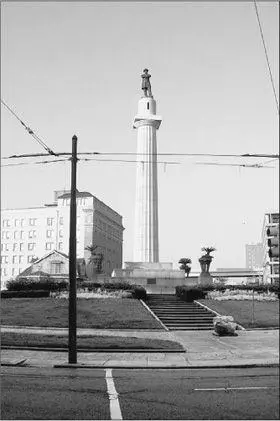
Statue of Robert E. Lee, Lee Circle, New Orleans
But Lee Circle is the focal point. The St. Charles Avenue cable car circumnavigates the circle at the beginning and end of its run past the genteel mansions of the uptown rich and powerful. Almost all the old-line Mardi Gras parades, from Comus on, have passed by here, where bleachers are set up to accommodate the cheering crowds. The fact that New Orleans fell without much resistance to a Union naval assault in April 1863 and that the Virginian Lee never set foot in the city during his time as commander of the Confederate forces does little to tarnish the general’s status as the first son of what is often called the Cult of the Lost Cause.
Standing there looking at the statue, I wondered what present-day New Orleans would look like to the man who said that slavery was “a greater evil to the white than to the colored race. While my feelings are strongly enlisted in behalf of the latter, my sympathies are more deeply engaged for the former. The blacks are immeasurably better off here than in Africa, morally, physically, and socially. The painful discipline they are undergoing is necessary for their further instruction as a race, and will prepare them, I hope, for better things. How long their servitude may be necessary is known and ordered by a merciful Providence.”
In keeping with the southern bromide that a man of honor should never turn his back on a Yankee, Lee faces northeast, which, during Katrina would have afforded him an excellent vista of the flooded Central Business District. A glance to the left and he could have seen the Superdome. A turn to the right would have given him a view of the nearby Crescent City Connection, the bridge across the Mississippi River to the Westbank Jefferson Parish communities of Gretna and Terrytown. Following World War II, the Westbank became an early “white flight” refuge for those who could no longer tolerate living in New Orleans with its rapidly increasing black population. Half a century later, in one of the most distressing of Katrina incidents, hundreds of stranded, desperate New Orleans residents attempted to cross the bridge in the days after the hurricane only to be turned back by cops under the command of the general’s namesake (albeit the Chinese version), Jefferson Parish sheriff Harry Lee. To show they meant business, the police fired a volley over the heads of the crowd, vowing to shoot whoever set foot on their side of the river.
One hundred and forty years after his surrender at Appomattox, what would the general in chief of the Confederacy think of that? This was a question I began asking around town. The responses were remarkably consistent. Several people quoted a bumper sticker seen on pickup trucks lined up at the frozen-daiquiri-to-go spots, at least the ones catering to whites: when it came to black people and their continued presence in the city, We Should Have Picked Our Own Cotton.
Elaborating on this theme was Dr. Raynard Sanders, a former public school principal who now spends his time steadfastly trying to save what’s left of the system in the city. “Robert E. Lee, oh, Robert E. Lee. Robert E. Lee would have watched what happened after Katrina and thought, well, things never change, do they? He would have seen another example of how the North will always desert the South when it is in need, and in that he’d be right, of course. As for what was happening to people trying to cross the bridge, Lee wouldn’t have cared about that, and not because he was so hard-hearted or hated black people. However, if those people were running away from a plantation, that would have been a different story altogether because then they would have had a business function. They’d be property, a means of production, worth something. What were those people on the bridge worth? Who did they belong to, what was their economic value in the society? No, they’d be invisible to Robert E. Lee.”
These conjectures about Lee’s opinions were interesting, but I found myself wanting more from the commander who ordered Pickett’s charge at Gettysburg, a military blunder that did much to seal the South’s fate. I wanted to know if Lee, the legendary gentleman, felt any regret or pain over the decisions he’d made, the side he’d chosen. I wanted to know if standing there at the center of his circle for 120 years, he had sometimes felt like shrieking, “Enough!” so loud that even the soused loungers inside the Circle Bar could hear. Or would he shout, like Marlon Brando’s Kurtz raging, “Kill them! Kill them all.”
Читать дальше
